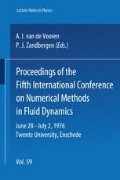Abstract
SLIC is an alternating-direction method for the geometric approximation of fluid interfaces. It may be used in one, two, or three space dimensions, and it is characterized by the following features: (1) Fluid surfaces are represented locally for each mixed- fluid zone, and these surfaces are defined as a composition of one space dimensional components, one for each coordinate direction. (2) These onedimensional components are composed entirely of straight lines, either perpendicular to or parallel to that coordinate direction. (3) The one-dimensional surface approximations for a mixed fluid cell are completely determined by testing whether or not the various fluids in the mixed cell are present or absent in the zone just to the left and to the right in the coordinate direction under consideration. (4) Because of the completely one-dimensional nature of the SLIC interface description, it is relatively easy to advance the fluid surfaces correctly in time. With the SLIC fluid-surface definitions, it should be possible to incorporate any one space dimensional method for advancing contact discontinuities. This makes SLIC very practical for the numerical solution of fluid dynamical problems.
This work was performed under the auspices of the U. S. Energy Research & Development Administration, under contract No. W-7405-Eng-48.
Preview
Unable to display preview. Download preview PDF.
References
W. F. Noh, “CEL: A Time Dependent, Two Space Dimensional, Coupled Eulerian Lagrange Code,” in Methods in Computational Physics, Vol. 3, Berni Alder, Sidney Fernback, and Manuel Rotenberg, eds. (1964, Academic Press, New York), pp. 117–180.
W. F. Noh, “A General Theory for the Numerical Solution of the Equations of Hydrodynamics,” in Numerical Solutions of Nonlinear Differential Equations, Donald Greenspan, ed. (1966, John Wiley & Sons, Inc.) pp. 181–211.
W. F. Noh, “Numerical Methods in Hydrodynamical Calculations,” Lawrence Livermore Laboratory, Report UCRL-52112 (1976).
A. A. Amsden, “The Particle-in Cell Method for the Calculation of the Dynamics of Compressible Fluids,” Los Alamos Scientific Laboratory, Report LA-3466 (1966). (Also see F. H. Harlow, LA-4281 (1970) for other useful code bibliographies.)
R. DeBar, “Fundamentals of the KRAKEN Code,” Lawrence Livermore Laboratory, Report UCIR-760 (1974).
W. G. Sutcliffe, “BBC Hydrodynamics,” Lawrence Livermore Laboratory, Report UCID-17013 (1973).
W. F. Noh and P. Woodward, “The SLIC (Simple Line Interface Calculation) Method,: UCRL-52111 (1976).
Author information
Authors and Affiliations
Editor information
Rights and permissions
Copyright information
© 1976 Springer-Verlag
About this paper
Cite this paper
Noh, W.F., Woodward, P. (1976). SLIC (Simple Line Interface Calculation). In: van de Vooren, A.I., Zandbergen, P.J. (eds) Proceedings of the Fifth International Conference on Numerical Methods in Fluid Dynamics June 28 – July 2, 1976 Twente University, Enschede. Lecture Notes in Physics, vol 59. Springer, Berlin, Heidelberg. https://doi.org/10.1007/3-540-08004-X_336
Download citation
DOI: https://doi.org/10.1007/3-540-08004-X_336
Published:
Publisher Name: Springer, Berlin, Heidelberg
Print ISBN: 978-3-540-08004-6
Online ISBN: 978-3-540-37548-7
eBook Packages: Springer Book Archive

